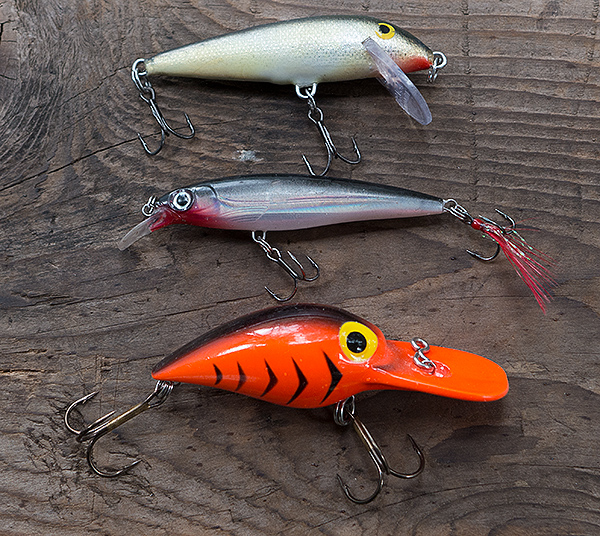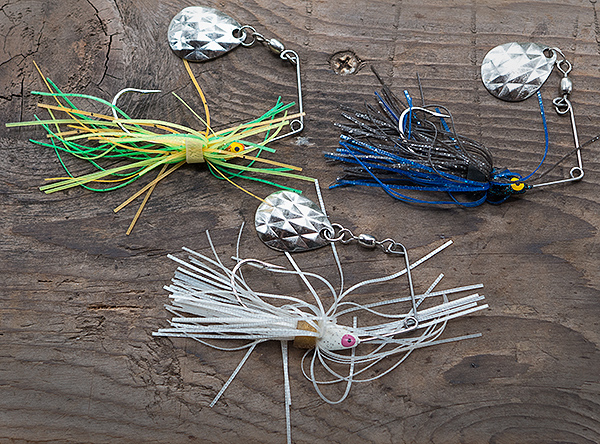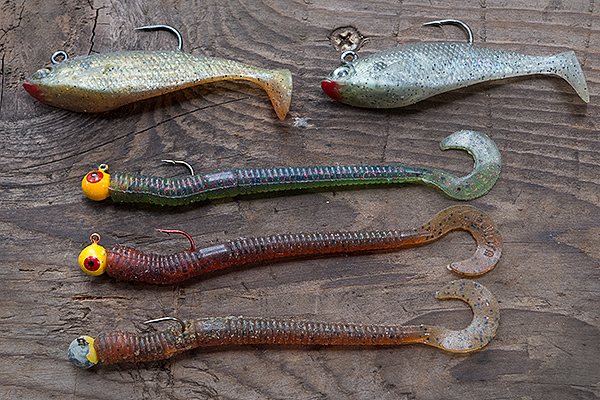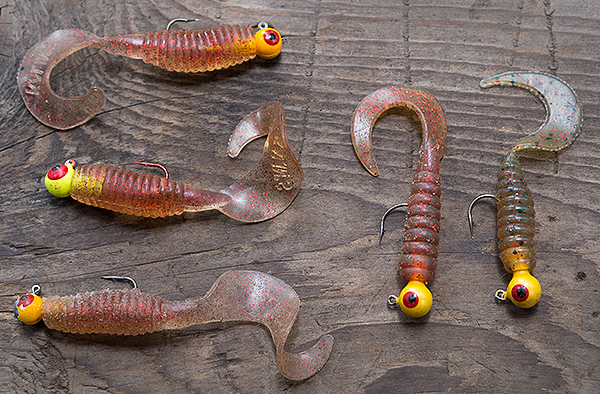A few days ago we took a look at some of the rods and reels we use for smallmouth bass fishing on the Columbia River, today we’ll have a look at some of the lures we use. All the lures in this article have been used over a period of time and all have caught smallmouth bass on a regular basis, that’s why we use them. As always, we here at watermanatwork.com are not “sponsored” by anybody and pay for our own gear, so many of these lures are on the less expensive side. Besides, the Columbia River is full of rocks and submerged trees so you will lose some tackle. The inexpensive lures catch just as many fish as the more expensive ones.
The first type of lures we use are crankbaits. In the photo below, the top lure is a Rapala Countdown, a basic weighted crankbait that runs below the surface but not too deep. It also has good action due to the large plastic lip. The lure in the middle is a Rapala X-Rap, an easy to cast, suspended lure that dives when retrieved or yanked. The crankbait on the bottom is the Storm Wiggle Wart. Wiggle Warts are a big favorite here in the Columbia River Gorge because they catch all kinds of fish from big smallmouth bass to trophy steelhead and salmon. By varying retrieve speed and jerking the fishing rod during the retrieve, crankbaits can be very effective for big smallmouth bass. We use crankbaits primarily in the spring, when smallmouth bass are spawning, by casting near spawning nests. They also work well when the bigger bass start moving from deeper water into the shallows early in the season. Crankbaits are not as effective as the water warms up and the fish head to deeper water. There are crankbaits that run deep, but run the risk of being snagged on rocks and submerged trees, which is not good because these lures tend to be rather expensive. The Wiggle Warts are about $5-7.00 or so, the Rapala Countdown and X-Rap are about $9-10.00, so you can see that losing this kind of lure can get pretty expensive. Everyone has their favorite crankbait for smallmouth bass and one lure may work better than another in different locations, but these are the crankbaits we use the most.

The next kind of lure we use are spinnerbaits. These lures work best when the smallmouth bass are active and swimming in shallow water or near rocky shorelines and submerged structure. Smallmouth bass are very aggressive fish and will hit these lures very quickly after they hit the water and start your retrieve. They are a lot of fun to fish with because bass of all sizes will hit them and hit them hard. Varying retrieve speed will often entice bass to bite. Trying different colors can make a big difference; we prefer the darker colors on overcast days and the brighter colored spinnerbaits on sunny days. Overall, the green and yellow spinnerbait is our favorite. Spinnerbaits cost anywhere from $4-7.00 and we have found that the cheaper lures work just as well as the brand name versions.

Next, we have soft baits, or plastics, as they are commonly known. This type of lure, as the name states, is a plastic version of some kind of bait with a hook in it. There are every kind of creature soft baits you can think of; worms, fish, lizards, crayfish, frogs and some things we are not sure what they are supposed to be. We are not going to cover every single type of plastic bait, just the ones we use most of the time. In the photo below, on top there are a couple Storm Wild Eye Shad swimbaits. The one on the right is unused, the one on the left was thrown into a tackle box with some other plastics and some of the color transfered(you can see the tail is about the same color as the reddish worms), so it’s a good idea to separate the colors, just like the laundry. We use these shad swimbaits in the same way we would use a crankbait. The big difference is the plastic swimbaits only cost a buck or two each so it’s a lot cheaper when you lose them. Below the swimbaits are three plastic worms with 1/8 ounce yellow lead heads. The top two worms are unused, the worm on the bottom has been well chewed by smallmouth bass and the paint has chipped off the lead head from bouncing off rocks. We fish these worms off the bottom; drop them down, wait a few seconds, reel in a little and let them drop to the bottom again. Many times, the fish will hit the bait as it falls towards the bottom. Plastic worms are some of the most popular smallmouth bass fishing lures because they catch a lot of fish and are pretty cheap; a worm and lead head is less than a dollar. They work very well in the heat of summer when the smallmouth bass have moved to the deeper parts of the river. We like the reddish or green worms best, they come in just about every color imaginable, so you have to find out which color works best for you.

Last, but not least, we use a soft bait called grubs. Grubs are our favorite smallmouth bass lure. We have caught more smallies on grubs than all the other types of lures put together. Not only do they catch every size of bass from six inches to twenty plus inch trophy fish, they are the cheapest lures of all. On the left in the photo below are three, three inch Kalin Lunker Grubs with 1/8 oz. lead heads. The grub on the bottom is just about chewed up by bass and the paint is chipped off the lead head from bouncing off rocks. The two grubs on the right are a different brand, but similar in color and size. We like the reddish or reddish brown colors because they look like crayfish, a smallmouth bass’s favorite food. Just like other soft baits, there are many different styles and color grubs. Fishing off the bottom, near rocky shorelines or around submerged rocks and structures, these humble grubs almost always catch fish. A grub and 1/8 oz. lead head is going to be in the two for a buck range so losing a few is not going to ruin your day.

We don’t use swivels or clips with any of these lures, tie the lure directly to the line. There are other ways to successfully fish for smallmouth bass on the Columbia River, but these basic lures should work nearly all the time. When fishing for bass and one lure isn’t working, try another one. One lure may work in the morning and another may work later in the day. When you get some bass fishing experience, it’s pretty easy to figure out what lure will be your best shot given the conditions at hand. A kayak is the perfect vehicle to go after smallmouth bass. Smallmouth bass are some of the best pound for pound fighters in fresh water and you can catch them just about anywhere on the Columbia River.

No one seems to carry the Kalin Lunker Grubs in the color you have in this article. I tried the link but don’t see them on their website. Any luck buying them lately? Thanks, Barry
They do seem to be hard to come by. You could try contacting them directly.
I think it’s Hard and Soft Lures.
Ron B